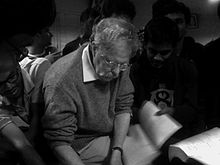David J. Griffiths
David J. Griffiths | |
|---|---|
 Griffiths in 2014 | |
| Born | 5 December 1942 |
| Nationality | American |
| Alma mater | Harvard University |
| Known for | Undergraduate textbooks |
| Scientific career | |
| Fields | Particle physics Electromagnetism |
| Institutions | Reed College |
| Thesis | Covariant Approach to Massless Field Theory in the Radiation Gauge (1970) |
| Doctoral advisor | Sidney Coleman |
| Signature | |
 | |
David Jeffrey Griffiths (born December 5, 1942) is an American physicist and educator. He was on the faculty of Reed College from 1978 through 2009, becoming the Howard Vollum Professor of Science before his retirement. He wrote three highly regarded textbooks for undergraduate physics students.
Early life and education
[edit]Griffiths was born in Arlington, Virginia, the son of Winifred Mary (née Jeffrey) and Gordon Griffiths.[1][2] Both his parents were faculty members at the University of Washington, his father in the history department[3] and his mother in the zoology department.[2]
Griffiths is a graduate of The Putney School and was trained at Harvard University (B.A., 1964; M.A., 1966; Ph.D., 1970). His doctoral work, Covariant Approach to Massless Field Theory in the Radiation Gauge on theoretical particle physics,[4] was supervised by Sidney Coleman.
Career
[edit]Griffiths is principally known as the author of three highly regarded textbooks for undergraduate physics students: Introduction to Elementary Particles (published in 1987, second edition published 2008), Introduction to Quantum Mechanics (published in 1995, third edition published 2018), and Introduction to Electrodynamics (published in 1981, fifth edition published in 2024).
Awards, honors
[edit]Griffiths was the recipient of the 1997 Robert A. Millikan award reserved for "those who have made outstanding scholarly contributions to physics education".[5][6]
In 2009 Griffiths was named a Fellow of the American Physical Society, cited "For advancing the upper level physics curriculum through the writing of leading textbooks and through his contributions to the American Journal of Physics in many editorial roles and as an author."[7]
Books
[edit]- Griffiths, David J. (2008). Introduction to Elementary Particles (Second, Revised ed.). Wiley-VCH. ISBN 978-3-527-40601-2.
- Griffiths, David J. (2012). Introduction to Electrodynamics (Fourth ed.). Addison-Wesley. ISBN 978-0-321-85656-2.
- Griffiths, David J.; Schroeter, Darrell F. (2018). Introduction to Quantum Mechanics (Third ed.). Cambridge University Press. ISBN 978-1-107-18963-8.
- Griffiths, David J. (2012). Revolutions in Twentieth-Century Physics. Cambridge University Press. ISBN 978-1-107-60217-5.[8]
The most recent edition of each book is generally regarded as a standard undergraduate text.[9]
See also
[edit]- List of textbooks in electromagnetism
- List of textbooks on classical mechanics and quantum mechanics
References
[edit]- ^ "Virginia, U.S., Federal Naturalization Records, 1901-1938". www.ancestry.com. 1937. Retrieved May 15, 2023.
- ^ a b "Mary Griffiths Scientist, Teacher, Activist". The Olympian. February 4, 2007. p. 18. Retrieved May 15, 2023.
- ^ "Gordon Griffiths papers - Archives West". archiveswest.orbiscascade.org. Retrieved May 16, 2023.
- ^ Griffiths, David Jeffrey (January 1, 1970). Covariant Approach to Massless Field Theory in the Radiation Gauge (PhD thesis). Harvard University. Bibcode:1970PhDT.........6G.
- ^ Griffiths, David (December 1997). "Millikan Lecture 1997: Is there a text in this class?". American Journal of Physics. 65 (12): 1141–1143. Bibcode:1997AmJPh..65.1141G. doi:10.1119/1.18777.
- ^ List of Robert A. Millikan Award Winners at the American Association of Physics Teachers website
- ^ "APS Fellow Archive". aps.org. Retrieved May 15, 2023.
- ^ Abernathy, William (September 2013). "Review of Revolutions in Twentieth-Century Physics by David Griffiths". Reed Magazine. 92 (3).
- ^ "Notes from the Outside Special: Meet David J. Griffiths" (PDF). The Dilated Times: The newsletter of the Drew University Society of Physics Students. Vol. 13, no. 2. Spring 2003. pp. 4–5. Archived from the original (PDF) on December 2, 2020.
External links
[edit]- Griffiths's web page
- AIP Oral History Interview
- Lecture: The charge distribution on a conductor
- "... could teach physics to gerbils."
- David Griffiths at the Mathematics Genealogy Project
- David Griffiths Lecture, Techfest 2012, IIT Bombay - YouTube
